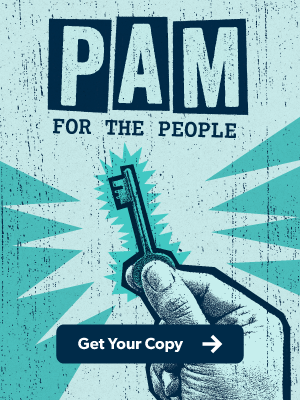In the world of cybersecurity, acronyms are everywhere.
Two of the most common, and often confused, are IAM (identity and access management) and PAM (privileged access management).
While they seem similar and are both crucial for protecting your digital assets, they address different aspects of your security posture.
So, is it PAM vs. IAM?
Not at all.
It’s more like PAM and IAM—two powerful allies working in concert.
Let’s demystify their relationship and understand how they work together to form a robust security strategy.
The Foundation: Identity and Access Management (IAM)
Think of identity and access management (IAM) as the bouncer at the front door of a nightclub. Its job is to manage and secure the identities of everyone who wants to enter—from the regular customers to the VIPs.
IAM is a broad framework that governs the entire lifecycle of a digital identity. It’s about answering three fundamental questions for every user in your organization:
- Who are you? (authentication): This is the process of verifying a user’s identity. It could be as simple as a username and password or as robust as multi-factor authentication (MFA) using biometrics or a one-time code.
- What can you do? (authorization): Once a user is authenticated, IAM determines what resources they are allowed to access. This is often based on their role within the organization (e.g., a marketing employee can access the marketing drive, but not the HR database).
- Do you still need access? (lifecycle management): IAM manages accounts from creation to de-provisioning. When an employee is hired, their account is provisioned with the right access. When they leave, their access is promptly removed.
In essence, IAM provides the foundation for your entire security posture by ensuring every user has a unique, verifiable identity and is granted the right level of access to perform their day-to-day tasks.
The Inner Sanctum: Privileged Access Management (PAM)
Now, let’s go back to our nightclub analogy.
While IAM is the bouncer for everyone, privileged access management (PAM) is the bodyguard for the VIP section. It doesn’t just manage identities; it manages the most powerful ones—the “keys to the kingdom.”
Privileged accounts are those with elevated permissions that can make significant changes to critical systems, sensitive data, and network infrastructure. This includes system administrators, IT staff, database administrators, and even automated accounts. A breach of a privileged account can be catastrophic, allowing an attacker to move laterally through the network, steal sensitive data, or take down entire systems.
PAM is a specialized subset of IAM that focuses on these high-risk accounts. Its framework is built on a few core pillars designed to enforce the principle of least privilege (PoLP).
- Secure access & control: A PAM framework starts with securing the privileged accounts themselves. It mandates that all access to sensitive systems must be controlled and brokered. This is achieved by storing credentials in a secure digital vault and granting access on a “need-to-know” basis. Modern PAM takes this a step further with just-in-time (JIT) access, which grants elevated permissions only for the time and specific task required, eliminating the risk of always-on administrative rights.
- Continuous monitoring & audit: The PAM framework demands a complete lack of blind spots. Every action performed by a privileged user is monitored and recorded in real time. This creates a detailed, immutable audit trail that provides full visibility into who accessed what, when, and for what purpose. This is essential for compliance and for forensic analysis in the event of a security incident.
- Policy & automation: The final pillar is the automation of policy enforcement. A robust PAM framework automates the entire privileged access lifecycle, from the request and approval workflow to the granting and revocation of permissions. This not only reduces the potential for human error but also ensures that security policies are consistently and efficiently applied without creating operational bottlenecks.
The Synergy: A Unified Approach to Layered Defense
It’s important to understand that PAM isn’t a replacement for IAM; it’s a critical and highly specialized extension. They are two sides of the same security coin. IAM provides the breadth, establishing secure identities and general access. PAM provides the depth, adding a layer of control for the most powerful and high-risk identities.
An integrated approach is the most effective. Your IAM system authenticates a user and determines their general permissions. If that user needs to perform a privileged action, your PAM solution takes over, verifying the request, granting temporary access, and monitoring the session.
JumpCloud: The Unified Platform for IAM and PAM
In the modern, cloud-first world, managing separate IAM and PAM solutions can be a complex and costly endeavor. This is where a platform like JumpCloud steps in. JumpCloud provides a unified, cloud-based platform that brings IAM and PAM together, simplifying management and strengthening your security posture.
JumpCloud’s platform acts as a central control plane for identity, access, and device management. Building on its foundational IAM capabilities like single sign-on (SSO), MFA, and user lifecycle management, the platform also delivers powerful PAM functionality.
With JumpCloud, you can:
- Enforce the principle of least privilege across your entire organization, ensuring no user has more access than they absolutely need.
- Grant just-in-time access to sensitive resources, eliminating the security risk of standing administrative privileges.
- Centralize control and visibility, giving you a single pane of glass to manage all user identities and monitor all privileged activity.
The Takeaway
The true power of modern security lies in unified identity and privilege management. By treating PAM and IAM not as separate concepts but as two parts of a single solution, you can build a more resilient defense against today’s sophisticated cyber threats.
Ultimately, by leveraging JumpCloud, you can create a seamless, layered security framework that protects against both internal and external threats, while saving your IT team time and resources. If you haven’t checked out JumpCloud yet, sign up for a free trial and see how a unified platform can transform your security.




